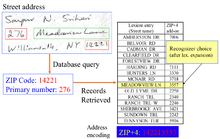Handwritten Address Interpretation

HandWritten Address Interpretation is a software system developed at the Center of Excellence for Document Analysis and Recognition of the State University of New York. Known as HWAI, it was first deployed by the United States Postal Service through its contractor Lockheed-Martin in Tampa, Florida during the holiday December season in 1997. Initially 10% of the handwritten mail was successfully sorted and the project was considered a success. This was due to the large volume of mail that the US Postal Service processes and the cost of labor involved. The key to the success was the discovery of a heuristic by researchers Sargur Srihari and Jonathan Hull that the street number and ZIP code could be relatively easily recognized, because they only consist of numerals, which could then be used to constrain the possible street. Subsequent improvements to HWAI led to a 45% sort rate with a 2% error rate. Today more than 95% of the handwritten mail is sorted automatically. Versions of HWAI were developed for Australia Post and UK Royal Mail.